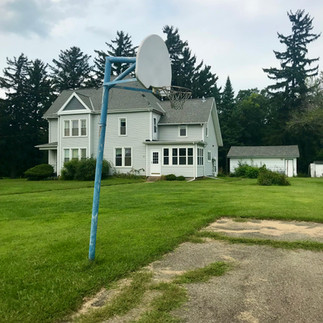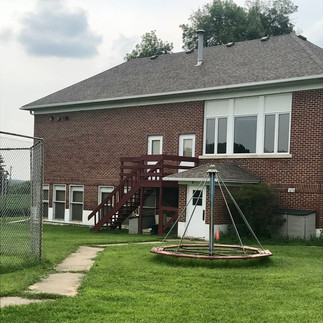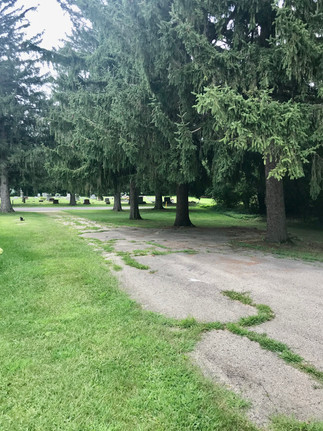What is a Koshkonong?
- Dan Madson
- Dec 17, 2023
- 13 min read
Updated: Dec 18, 2023
My family moved from Minnesota to Wisconsin in the summer of 1971. I, for one, was not a happy camper. I had passed Mrs. Lundberg’s rigorous 5th grade class with flying colors and was about to become a 6th-grader, top of the food chain at the elementary school in Luverne, Minnesota. One night that spring my father informed the family that he had accepted a Divine Call to become the pastor of a small country parish in southern Wisconsin called Western Koshkonong Lutheran Church. I don’t recall who, but one of us kids asked, “Dad, what is a Koshkonong?” That night when mom put us to bed, it was apparent that she, like her children, was none too excited about the impending move. We were all happy living in Luverne!

I’ll never forget the day the movers came later that summer. Three farmers from the church in Wisconsin pulled up in a large moving truck. One guy name Fred wore pants with stars on them, and he forever became known as Star Man to us kids. I had expressed my opposition to the move on many occasions as only a sullen pre-teen can do. I had sold my extensive baseball card collection to my friend David Sanny for 50 cents. Let it be known that in that collection were at least a dozen Carl Yastrzemski, Pete Rose and Rod Carew rookie cards that would be worth a fortune today. SMH. I used the money to buy a bag of lemon drops which lasted me the entire trip to Wisconsin. I remained sullen as we piled into the family’s brown Ford station wagon. I sat in the back seat and cried for the first hour of the six-hour trip.
When we arrived at Koshkonong, I kid you not, it was out in the middle of nowhere. An exile to Siberia couldn’t have been more forlorn. There was a church and cemetery, a two-room school and a large parsonage that was to be our new home. Nothing else as far as the eye could see but huge pine trees and fields of corn, alfalfa and soybeans. After we unpacked, I sat on the steps outside our new home and vowed that I would never speak to my parents again. But then, as nature would have it, my stomach started growling. I walked into the kitchen and said, “Mom, can I have something to eat?”
As I sat on the back stoop devouring a peanut butter sandwich, a kid rode up the sidewalk on a bike. He stopped and said, “Hi. My name is Byron Orcutt. Do you have a bike?”
I said, “Sure.”
He said, “You wanna go for a ride?”
I said, “Sure.”
I retrieved my green Schwinn Stingray from the garage and we set off down the road. Turns out, he lived about a mile from the parsonage, across a field and down a steep hill. We sped down that hill toward his house at what seemed like 80 miles an hour. At the bottom, he skidded into his driveway and showed me where he lived. We spent the afternoon together. He showed me around and introduced me to his cousins the Bolanders who lived nearby. Thus started a friendship that would last for the next three years, and also, thus started the second half of my childhood.
As Donald Rumsfeld once said, “You don’t know what you don’t know.” Looking back, those words were certainly applicable to my situation. As disappointed as I was being moved to a new state, little did I know that my years at Koshkonong would make up the defining formative years of my life.
I would attend a two-room country school for three years. I would meet a lot of wonderful, memorable people. I would attend an area Lutheran high school and meet the girl I would eventually marry. I would learn how to work; I would learn how to compete; I would learn how to fend for myself. A boy would become a man.
**********************************************************************************
A couple years ago, while on a trip to Madison, I drove out to my old stomping grounds to take a look around. It was disheartening to see that much of the Koshkonong property had fallen into disrepair. The church is still being used for worship, but the school has been closed for years and the parsonage is uninhabited. Time and nature have a way of ruining things when they are not being used and maintained. But...back in its heyday...weeeeeee!
The School
I had attended a large public school from kindergarten through 5th grade. I spent the next three years at a two-room country school with a total of 45 students. My dad had been charged by the congregation with trying to build the school into a viable educational option for members of the parish and the local community. The School Board called a baby-faced first-year teacher right out of college to serve as principal and teacher for grades 5-8. His name was Larry Rude, a farm boy from Zumbrota, MN. He turned out to be a real gem. He was a gifted teacher, coach and mentor to a generation of Koshkonong kids. Since there was no place for him to live near the school and he had to subsist on a meager salary, my parents invited him to stay with us. He bunked in an upstairs bedroom across from me and my brother. He ate breakfast with us in the morning and then spent the rest of his days and evenings at school working – planning lessons, correcting papers, fixing things in the school, etc. We called him ‘Larry’ at home and ‘Mr. Rude’ when we were in school. How he managed to teach 23 kids in grades 5-8 every subject every day, I’ll never know. But he was a creative, interesting, gentle soul who could be tough with us when necessary. Trust me when I tell you that it was quite often necessary.
The younger kids in the room next door were taught by Miss Susan Bly and later by Mrs. Cheryl Heileger, two excellent teachers as well. Downstairs we had a play room and two bathrooms. We couldn’t play basketball because we had no baskets so we put squares of masking tape high up on the wall to serve as baskets. Our favorite game was warball where we would throw rubber balls at each other’s heads from short distances. Full grown 8th grade boys chucking balls at 1st and 2nd graders who thought they were tough led to lots of tears and some interesting injuries. Right, Scotty Hougan?
The brown brick school building sat across the road from the church. Out back there was a small basketball court with two crooked hoops, a merry-go-round, teeter totters, a jungle gym and a back stop for the ball field. The perimeter of the play area was a corn field one year, an alfalfa field the next, a soybean field the next. Balls hit or kicked into the field had to be searched for when the crops had grown. Mr. Rude had played soccer in college, so he taught us kids the official rules of the game. He would occasionally play with us at recess and, nifty as he was on his feet with a soccer ball, we occasionally got the best of him. I remember knocking him to the ground once while playing. I didn’t know whether to be proud that I had won a minor conflict or scared that I had drilled my own teacher. He got up, kept playing and never said a word about the grass stains on his dress pants.
The Church
Western Koshkonong Lutheran Church is a classic, gothic-style, brick church with a beautiful bell tower and steeple. Built in 1891 at a cost of $7,433.80, the building has survived for well over a century. When we lived there in the ‘70s, the project that gave everybody a thrill was when they re-shingled the steeple and painted the bell tower. We kids would walk over to the church at recess and watch the brave roofers as they hung from ropes 100 feet off the ground.

My dad had his office at the parsonage but still spent a fair amount of time at the church. My younger brother, Mike, and I often had the run of the place when nobody was there. Our favorite thing to do was to take a pile of old bulletins, tear them in half and make paper airplanes. My brother was a master paper airplane maker. We would make 50 or 60 planes of various designs, take them up into the balcony and then launch them across the expanse of the church. Our goal was to land one in the gold collection plates that were kept on the altar. We would try to pick up all the mess when we were done, but it was hard when some of the planes got stuck in the hanging lights or on top of the sacristy doors. Once I remember seeing a plane stuck near the top of the Christmas tree. Hopefully people thought it was an ornament. More than once we sat snickering in church when we noticed that one of our planes was still in service!
On New Year’s Eve, my dad would take us all over to the church at 11:45. We would climb into the balcony where the rope to ring the bell hung behind the pews. At the stroke of midnight, each of us kids would take turns ringing the bell. Heavy as it was, if you hung on to the bell rope after pulling it down it would yank you right off the floor and into the air.
Three of us kids were confirmed in that church by our father. My class was one of the larger ones in the history of the church. I still remember all the kids in these pictures. Some of them attended our country school and the rest went to public school in the city of Stoughton, eight miles southwest of Koshkonong.
During the summer months when I was always looking for ways to earn money, the church council hired me to mow the entire parsonage, school, church and cemetery properties. I took over for a septuagenarian named Harvey Schwartzlow who was getting too old for the job. My pay was $275 for the entire summer. I did the math once. Averaging 16 mowings per season, I was making about $2.14 an hour. I had at my disposal an International Harvester Cub Cadet riding lawn mower and a green Lawnboy push mower, of the two-cycle engine variety. I trimmed around each of the gravestones every week and then rode and mowed to my heart’s content for the rest of the day.
It’s said that the church building was constructed on a firm, natural limestone base, a pretty good picture of the sound spiritual preaching that could be heard inside. Today, this church built on the hill not only serves as a local landmark, but as an important reminder of the past and a memorial to its proud founders who labored so diligently to raise it 132 years ago. The sign out front of the church while my dad was there was short and sweet: ‘We Preach Christ Crucified.’
The Parsonage
We had always lived in homes provided by the congregations in which my dad served. It was part of the lavish lifestyle of a small-town Norwegian Lutheran minister. The parsonage at Koshkonong was huge! There were four of us kids now with a fifth that would arrive – SURPRISE! – in a couple of years. My brother and I shared a bedroom upstairs. My two sisters did the same down at the end of the hallway after Mr. Rude moved in. My dad’s office was across the hall from us. The master bedroom was downstairs right below us. My brother and I often fell asleep listening to my mom play piano late at night when all her work was finished or listening to the muted hum of mom and dad discussing whatever it is that moms and dads discuss when they go to bed.
Given the size of the house and the fact that one person – namely Mom – couldn’t possibly take care of everything, we were all expected to help out. Every Saturday morning before we kids could do anything, mom would write out a list of jobs for each of us to complete. There was the usual complaining about the unfairness of it all, but in the end, we chipped in to prevent our mother from going insane. Or even worse, strapping us all into the back of our station wagon and driving into Lake Koshkonong. We made beds, picked up clothes, cleaned bathrooms, shook out rugs, vacuumed carpets, swept and washed floors, took out the trash and weeded the garden.
The basement of the parsonage was cold and damp. There was room for a washer and dryer and there was a large fruit cellar where mom stored all the fruits and vegetables she canned each year. There was a clothes chute that ran from the upstairs down to the basement. The dirty clothes dropped from on high would land in a large wooden cage that had been built underneath the chute. We had quite a few cats that roamed the property. I remember one day my brother and I thought it would be fun to see what would happen if we dropped a cat down the clothes chute. We ran to the basement and piled a bunch of dirty clothes and towels in the cage and then grabbed Two Face, one of our ‘pet’ cats. We took her upstairs, opened the door to the chute and dropped the feline. She let loose with a wailing MEEOOOOWWWWWas her claws frantically sought perch in the metal lining of the chute. Relax, PETA, she landed feet first, as cats tend to do, in the pile of clothes. She made a beeline for the back door, and I don’t think we saw her for a couple days after that. Do cats really have nine lives? This one did.
We spent nine Thanksgivings, Christmases and Easters in this house. We watched a lot of football games in the T.V. room. We practiced piano. We played various other squeaky instruments and did homework around the oak table in the dining room. Well, my sister did homework anyway. I usually set my books on the table and picked them up in the morning on the way to school. We played records on the old Magnavox cabinet stereo system. It was a warm and wonderful home for a busy, growing family.
The People
While the structures at Koshkonong were memorable, it was the people who lived there that made it truly special. A majority of the members of the church were farmers. A majority of those farmers were descendants of Scandinavian immigrants that had settled the area in the early 1800s. There were Skaalens and Juves, Nordlies and Gulseths, Olsons and Arnesons, Hagens and Hougans, Hansens, Swensons, Tollefsons, and Jorgensons.
Along with Byron, the first friend I made after we moved, my siblings and I hung out with kids from the Oris Hougan clan. Oris and his crew ran a sizable dairy and tobacco farm a few miles from Koshkonong. He had 11 children. I still know their names from oldest to youngest: Joannie, Connie, Tom, Steve, Laurie, Ann, Lucy, Joey, Mike, Scotty and Susie. Lucy was in my class; Ann was in my sister’s class and Joey was in my brother’s class. Well, they pretty much had a child in every class.
I’ll never forget the time I was at their farm helping them harvest tobacco. After they milked the cows that evening, I was invited to stay for dinner. I had never seen anything like it. Out on the front porch were a large refrigerator and chest freezer. Margaret, the mom, had chains wrapped around the units with padlocks in place to keep the doors from being opened and the contents from being raided. After we said a table prayer, the feeding frenzy began. I was used to eating fast because even in a family with four hungry kids, whoever ate fastest got the most. Seven or eight of the eleven kids were home that day, along with me. Nobody said a word. They just ate. And ate. And ate. Very fast. Picture a pack of hyenas devouring the carcass of a dead animal. I sat and watched in stunned silence and barely got any food!
The people that made up the congregation of Western Koshkonong Lutheran Church had some common qualities:
They worked hard. Up before dawn every day to milk cows, they also labored to raise the crops that supported their dairy cattle. Many of them also raised tobacco, a lucrative cash crop peculiar to this part of the state.
They were generous. My mom had six mouths to feed on a tight budget. My dad gave her three $20 bills each week for groceries. The rest of our food came from our garden. I personally hated that God-forsaken, weed-infested plot of land in our back yard. Mainly because I was forced to weed it. In addition, members of the congregation gave us food. When a farmer would butcher a steer for meat, quite often he would stop by with 20 or 30 lbs. of ground beef for us. When Lila Mae Nordlie butchered 40 chickens each fall, my mom would go down and help her. In turn, she would give us 20 of those chickens to put in our freezer to use during the year. Whenever we needed milk, my dad would drive down to the Nordlie farm with two 1-gallon pails and dip fresh milk right out of the bulk tank.
They were helpful. My dad was good at a lot of things. Fixing furnaces wasn’t one of them. Actually, he couldn’t fix anything. His tool box consisted of...wait, he didn’t even have a tool box. When something at the church or school needed fixing, he would call Lloyd Juve, a sinewy, tanned farmer that lived down the road a mile or so. The one time dad tried to fix the pilot light in the church furnace, it exploded. He’s lucky he wasn’t blown to smithereens. Lloyd, like most farmers, could fix anything. He was permanently on call as our maintenance man. Whenever there was a program or something that involved a lot of people at the church or school, volunteers would come out of the woodwork. The school had a Mothers Club that helped with school projects. The church had a Ladies Aid that helped with church events. Church potlucks at Koshkonong? Legendary.

They were friendly. Scandinavian farmers tend to be a stoic bunch. I come from that vein so I know. Beneath the stoicism, however, lurked genuine kindness, friendliness and emotion that showed itself in ways too numerous to mention. One example will suffice: after nine years at Koshkonong, my dad decided to take another call and return to central Minnesota. He preached a farewell sermon in the summer of 1980. The church was full of farmers who had just come from doing chores, dutifully cleaned and primped... as cleaned and primped as farmers can be. Normally, it was not unusual for some of them to nod off sitting inside a warm church. On this day, as my dad said his goodbyes, these normally stoic farmers and their wives sat in the pews and cried, not in the least bit ashamed at this unusual show of emotion. Hankies came out; noses were blown; tears fell freely.
I have nothing but good memories of my years at Koshkonong. I would bet to say that my parents, God rest their souls, and all my siblings would agree!
So, what is a Koshkonong? There has been some dispute about the origin and meaning of the word. Linguist Frederic Cassidy has, what I consider to be, the best answer. Koshkonong is a word from the Ojibwe Indians. It means ‘a sheltered place behind a windbreak.’ If you could see the church today, sheltered behind a row of giant, stately pine trees, I think you would understand.




























































Oh my goodness, I thoroughly enjoyed this! Having lived near there for 14 years I can see it all very clearly in my head how it was laid out. You tell the best stories! I will have to make a point to seek it out the next time I visit my brother.
You have an unbelievable memory! And…. How wonderful that your memories are full of love, adventure, Faith and Lessons! Great article! And…..photos too!
Well written, Dan! When we lived in Fort, I always enjoyed driving by your old stomping grounds!